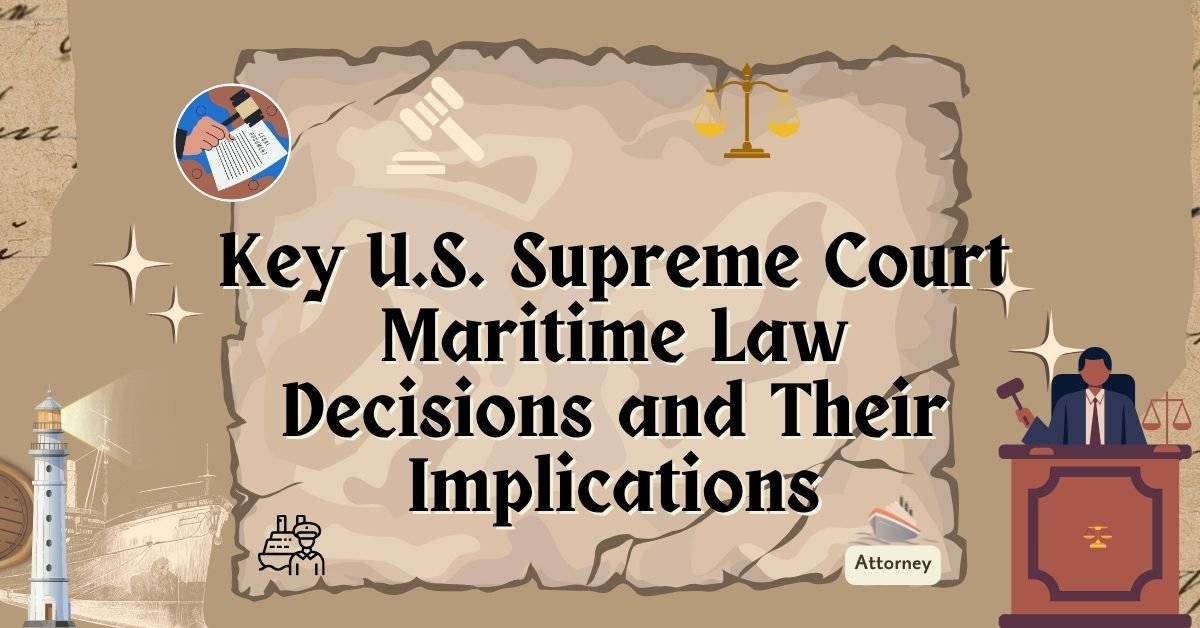1. Introduction
Maritime law, also known as admiralty law, is a distinct legal framework governing maritime activities, including shipping, navigation, and marine commerce. Decisions made by the U.S. Supreme Court have played a pivotal role in interpreting and shaping this unique branch of law.
2. The Foundation of Maritime Law
Before delving into specific cases, it’s essential to understand the foundational principles of maritime law, which are rooted in centuries-old customs and international conventions. These principles guide the legal treatment of maritime matters.
3. Significant U.S. Supreme Court Maritime Law Decisions
Let’s explore some of the landmark U.S. Supreme Court decisions that have had a lasting impact on maritime law:
3.1. The Osceola
The Osceola decision in 1903 addressed the scope of federal maritime jurisdiction and set precedents for cases involving seamen’s rights and personal injury claims.
3.2. Southern Pacific Co. v. Jensen
This decision in 1923 questioned the applicability of state laws in maritime cases, highlighting the tension between state and federal jurisdiction in maritime law.
3.3. Moragne v. States Marine Lines, Inc.
Moragne v. States Marine Lines, Inc. in 1970 extended the availability of wrongful death claims to survivors of maritime accidents, significantly impacting liability and compensation.
3.4. Executive Jet Aviation, Inc. v. City of Cleveland
This 1987 decision clarified the extent of admiralty jurisdiction and its limitations, particularly in cases involving aircraft on water.
3.5. American Dredging Co. v. Miller
American Dredging Co. v. Miller in 1994 examined the issue of punitive damages in maritime cases, influencing how punitive damages are awarded.
3.6. Stewart v. Dutra Construction Co.
The Stewart decision in 2002 addressed the important issue of maritime contracts and the rights and obligations of parties involved in maritime commerce.
3.7. Lozman v. City of Riviera Beach
Lozman v. City of Riviera Beach in 2013 focused on the definition of a “vessel” in maritime law, with implications for maritime property and regulations.
3.8. Dana v. Gould
Dana v. Gould in 1926 dealt with the enforceability of arbitration clauses in maritime contracts, impacting dispute resolution methods in the industry.
3.9. Yamaha Motor Corp. v. Calhoun
This 2006 decision examined the issue of product liability in maritime contexts, affecting manufacturers’ liability in maritime accidents.
3.10. Air & Liquid Systems Corp. v. DeVries
In 2019, this decision addressed the liability of manufacturers for asbestos-related injuries, setting standards for product liability in maritime cases.
4. Implications of Supreme Court Decisions
The Supreme Court decisions have far-reaching implications on various aspects of maritime law, including jurisdiction, liability, compensation, and dispute resolution. These rulings have shaped the legal rights and responsibilities of parties involved in maritime activities.
5. Challenges and Evolving Perspectives
While these decisions have provided clarity in many areas, challenges and evolving perspectives within the maritime industry continue to raise legal questions. Ongoing developments require a nuanced understanding of maritime law.
6. Conclusion
The U.S. Supreme Court’s maritime law decisions have played a vital role in defining the legal parameters of this intricate field. These rulings have influenced how maritime matters are litigated, regulated, and resolved, ensuring the protection of rights and interests in maritime activities.
7. FAQs
Q1: What is the significance of the Osceola decision in maritime law?
The Osceola decision in 1903 set important precedents for seamen’s rights and personal injury claims, establishing federal maritime jurisdiction.
Q2: How did the Moragne v. States Marine Lines, Inc. decision impact maritime law?
Moragne v. States Marine Lines, Inc. in 1970 extended wrongful death claims to survivors of maritime accidents, impacting liability and compensation.
Q3: What was the outcome of the Executive Jet Aviation, Inc. v. City of Cleveland case?
This 1987 decision clarified admiralty jurisdiction and its limitations, especially in cases involving aircraft on water.
Q4: How did the American Dredging Co. v. Miller decision affect punitive damages in maritime cases?
American Dredging Co. v. Miller in 1994 addressed punitive damages in maritime cases, influencing how they are awarded.
Q5: What is the significance of the Lozman v. City of Riviera Beach case in maritime law?
Lozman v. City of Riviera Beach in 2013 defined the concept of a “vessel” in maritime law, impacting property and regulations in maritime contexts. Play sprunki phase 28 Anytime, Anywhere!
